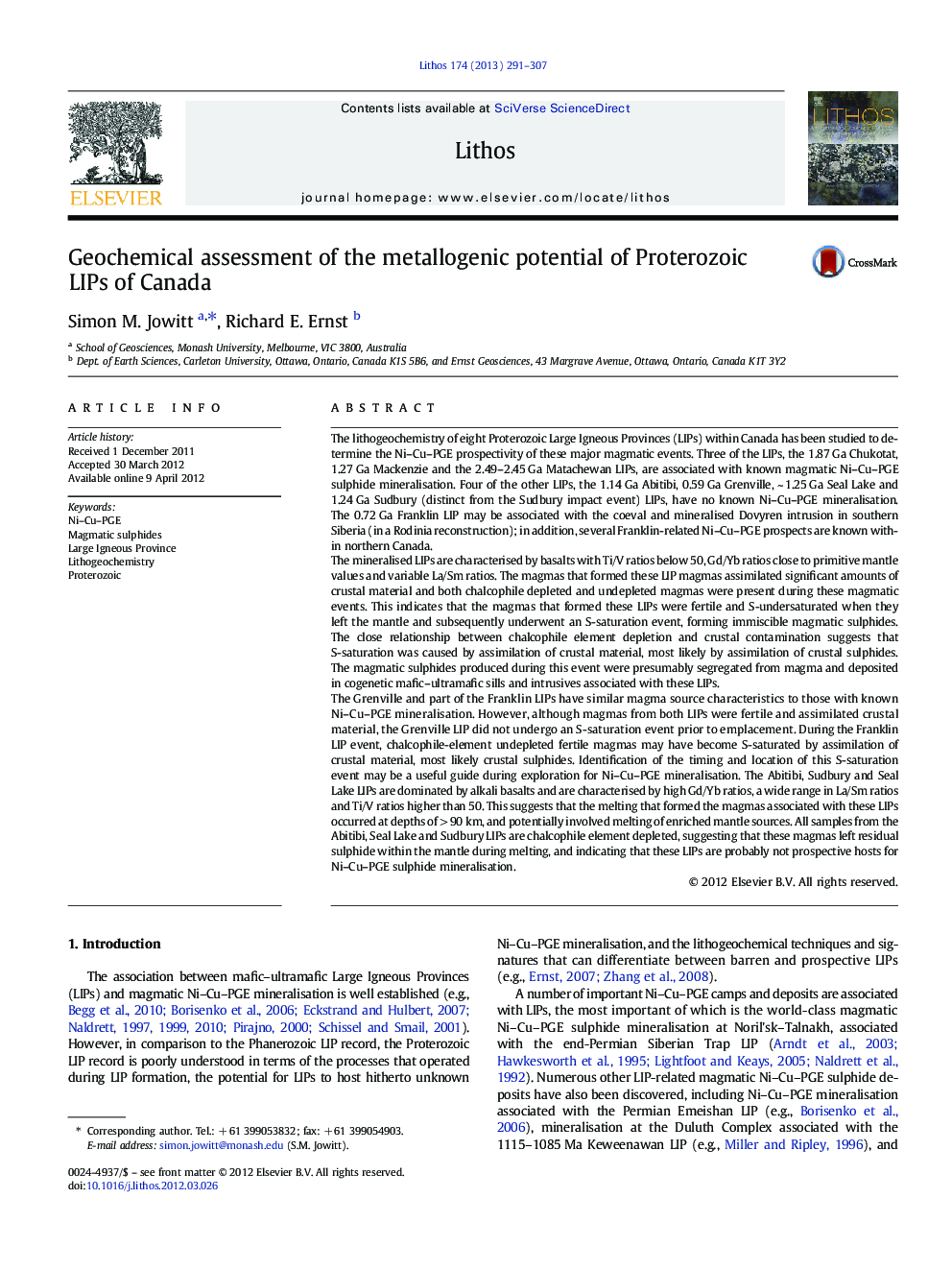| کد مقاله | کد نشریه | سال انتشار | مقاله انگلیسی | نسخه تمام متن |
|---|---|---|---|---|
| 4716193 | 1638690 | 2013 | 17 صفحه PDF | دانلود رایگان |

The lithogeochemistry of eight Proterozoic Large Igneous Provinces (LIPs) within Canada has been studied to determine the Ni–Cu–PGE prospectivity of these major magmatic events. Three of the LIPs, the 1.87 Ga Chukotat, 1.27 Ga Mackenzie and the 2.49–2.45 Ga Matachewan LIPs, are associated with known magmatic Ni–Cu–PGE sulphide mineralisation. Four of the other LIPs, the 1.14 Ga Abitibi, 0.59 Ga Grenville, ~ 1.25 Ga Seal Lake and 1.24 Ga Sudbury (distinct from the Sudbury impact event) LIPs, have no known Ni–Cu–PGE mineralisation. The 0.72 Ga Franklin LIP may be associated with the coeval and mineralised Dovyren intrusion in southern Siberia (in a Rodinia reconstruction); in addition, several Franklin-related Ni–Cu–PGE prospects are known within northern Canada.The mineralised LIPs are characterised by basalts with Ti/V ratios below 50, Gd/Yb ratios close to primitive mantle values and variable La/Sm ratios. The magmas that formed these LIP magmas assimilated significant amounts of crustal material and both chalcophile depleted and undepleted magmas were present during these magmatic events. This indicates that the magmas that formed these LIPs were fertile and S-undersaturated when they left the mantle and subsequently underwent an S-saturation event, forming immiscible magmatic sulphides. The close relationship between chalcophile element depletion and crustal contamination suggests that S-saturation was caused by assimilation of crustal material, most likely by assimilation of crustal sulphides. The magmatic sulphides produced during this event were presumably segregated from magma and deposited in cogenetic mafic–ultramafic sills and intrusives associated with these LIPs.The Grenville and part of the Franklin LIPs have similar magma source characteristics to those with known Ni–Cu–PGE mineralisation. However, although magmas from both LIPs were fertile and assimilated crustal material, the Grenville LIP did not undergo an S-saturation event prior to emplacement. During the Franklin LIP event, chalcophile-element undepleted fertile magmas may have become S-saturated by assimilation of crustal material, most likely crustal sulphides. Identification of the timing and location of this S-saturation event may be a useful guide during exploration for Ni–Cu–PGE mineralisation. The Abitibi, Sudbury and Seal Lake LIPs are dominated by alkali basalts and are characterised by high Gd/Yb ratios, a wide range in La/Sm ratios and Ti/V ratios higher than 50. This suggests that the melting that formed the magmas associated with these LIPs occurred at depths of > 90 km, and potentially involved melting of enriched mantle sources. All samples from the Abitibi, Seal Lake and Sudbury LIPs are chalcophile element depleted, suggesting that these magmas left residual sulphide within the mantle during melting, and indicating that these LIPs are probably not prospective hosts for Ni–Cu–PGE sulphide mineralisation.
► Lithogeochemical study of eight Proterozoic LIPs in Canada
► Ni–Cu–PGE prospectivity of mafic LIPs is determined using key lithogeochemical indices
► Prospectivity is related to magma sourcing, fertility and crustal contamination.
► Matachewan, Mackenzie, Chukotat and Franklin LIPs are prospective.
► Seal Lake, Abitibi, Grenville and Sudbury LIPs may be unprospective.
Journal: Lithos - Volume 174, 1 August 2013, Pages 291–307